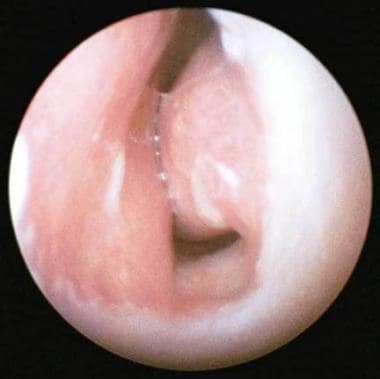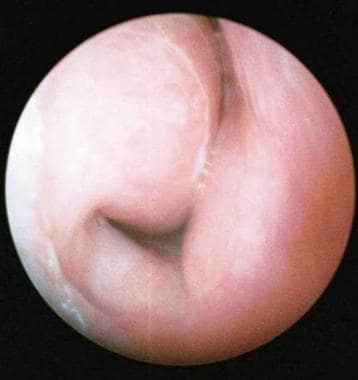Practice Essentials
All individuals have turbinate dysfunction at some point in their lives. Symptoms of turbinate dysfunction range from total nasal obstruction to mild congestion and/or rhinorrhea. Causes of turbinate dysfunction include upper respiratory infection (URI), allergic rhinitis, and vasomotor rhinitis. Drugs or hormones may also induce turbinate dysfunction. This article discusses the common and less common causes of this problem and its focused management. See the images below.
Workup in turbinate dysfunction
Sinus computed tomography (CT) scanning is useful for delineating the extent of disease in patients who have underlying chronic rhinosinusitis or acute recurrent rhinosinusitis, while rhinomanometric testing is an effective research tool for the evaluation of certain parameters of nasal airflow.
Eosinophilic infiltration of the mucosal membranes leads to suspicion of allergic causes for turbinate inflammation.
Management of turbinate dysfunction
Nasal decongestants, in topical or oral form, are some of the most effective drugs available for reducing congestion of the turbinate mucosa.
Surgical therapy is reserved for symptomatic patients with persistent hypertrophy of the turbinates who are not responding to medical management or in whom medical management is contraindicated. If bony hypertrophy is present, then some form of resection is necessary, either by way of an actual trimming of the bone and mucosa or through submucosal resection of the turbinate bone. [1]
Problem
Nasal congestion is the most common symptom associated with turbinate dysfunction. Symptoms may be mild, or the congestion may be so great that the only relief is to overuse (abuse) topical decongestants such as oxymetazoline or phenylephrine. Many patients have tried over-the-counter (OTC) oral decongestants with limited success. The key to successful management is to identify the underlying cause of the turbinate hypertrophy and either correct or treat the cause. Infectious and inflammatory causes are the most common etiologies.
Epidemiology
Frequency
Turbinate dysfunction is universal. Every person experiences some degree of turbinate dysfunction at some point in his/her lifetime. Persistent dysfunction is not uncommon and involves approximately 50% of the population.
A study by Clark et al of 1906 patients from different US regions with sinonasal complaints found the prevalences of nasal valve collapse, septal deviation, and inferior turbinate hypertrophy were 67%, 76%, and 72%, respectively. Of the 1211 patients with the most severe/extreme Nasal Obstruction Symptom Evaluation (NOSE) scale scores (55 or above), the prevalences were 73%, 80%, and 77%, respectively. Thus, these three sources of nasal obstruction occurred at comparable rates in both groups. [2]
Etiology
The etiology of turbinate dysfunction is multifactorial. Because the turbinates have a very rich blood supply and are governed by the parasympathetic nervous system, anything that affects either of these 2 systems affects the turbinates and, hence, the nose. [3]
Allergic rhinitis is the most common cause of turbinate dysfunction. Allergic rhinitis is due to environmental allergens that come in contact with the nasal membranes, causing an inflammatory reaction and resultant congestion and increased drainage. This category is so large that any nonallergic cause of turbinate dysfunction is known as vasomotor rhinitis. Vasomotor is a term that indicates the neurovascular control of the nasal membranes. Causes of vasomotor rhinitis include, but are not limited to, the use of cardiovascular and antihypertensive drugs, female hormones, changes in temperature, and rhinitis of disuse.
Any medication a patient takes that stimulates the parasympathetic nervous system can also affect the turbinate mucosa and cause congestion. Female hormones, specifically progesterone, may have a similar effect; therefore, congestion can frequently be experienced during the premenstrual phase of the menstrual cycle and the third trimester of pregnancy. Some female hormone replacement therapy and oral contraceptives that have a higher concentration of progesterone may have similar effects, although a 2006 small clinical study did not demonstrate that effect. [4]
Condensation rhinitis is well known to snow skiers and is due to the reaction of the nasal membranes to the colder outside environment. An equivalent example is that of taking a cold beverage can outside on a hot day and finding condensation developing on the outside of the can.
Rhinitis of disuse occurs in patients who no longer use their noses for airflow (eg, patients who have undergone laryngectomy) or those who abuse topical nasal decongestants (rhinitis medicamentosum). In the first case, the underlying pathophysiology is rebound inflammation due to a lack of feedback from the normal nasal airflow. In the second case, a rebound vasodilation of the turbinates occurs as a response to the topical sympathomimetics.
Pathophysiology
Similar to the rest of the upper respiratory tract (URT), the membranes of the turbinates are composed of ciliated, pseudostratified, glandular, columnar epithelium. The cilia beat in unison to propel the mucus from the nasal cavity toward the nasopharynx, where the mucus can then be swallowed. Mucociliary transport relies on mucus production and ciliary function. Normally, the nose and paranasal sinuses produce approximately 1 quart of mucus in a 24-hour period. When inflamed, that amount can more than double. Mucus contains immunoglobulin A (IgA), immunoglobulin E (IgE), and muramidase.
Both the blood supply and the autonomic nervous system control the secretions and level of congestion of the turbinates. The autonomic nervous system provides the general innervation to the nose, with the parasympathetic nerves supplying the resting tone and controlling secretions. The nerve supply originates from the facial nerve at the superior salivatory nucleus and follows along the distribution of the facial nerve through the sphenopalatine ganglion. The blood supply to the nose comes from branches of both the internal and external carotid artery systems. The terminal branches of the internal maxillary artery supply most of the mucosal surfaces of the nasal cavity.
Presentation
Patients with turbinate dysfunction report nasal congestion, postnasal drainage, and occasionally, midfacial headaches or facial pain and discomfort. Anterior rhinorrhea is less common but may be noted. These symptoms can occur irrespective of etiology. If marked swelling of the turbinates results in contact with the septum or lateral nasal wall, then nasal headaches may occur. Patients report pressure and headaches in the central forehead and medial canthal regions. Symptoms of congestion in some cases may be so bad that the patient develops an addiction to OTC nasal sprays containing either oxymetazoline or phenylephrine. This condition is known as rhinitis medicamentosum. See the image below.
 Mucosal hypertrophy of the left inferior turbinate with impingement of the septum and narrowed nasal airway.
Mucosal hypertrophy of the left inferior turbinate with impingement of the septum and narrowed nasal airway.
Intermittent blockage of 1 nasal passage followed by switching of the congestion to the other nasal passage is a common report and is known as the nasal cycle. Patients may describe positional congestion, such as when lying on 1 side while sleeping. The nose is thought to shut down 1 nasal passage every 2-4 hours in order to prevent desiccation and irritation from inhaled air. The extent of this shutdown can range from complete obstruction to a slight degree of congestion that is hardly noticed. Treatment is not required unless the symptoms are exaggerated because this shutdown is part of normal nasal physiology.
If a middle turbinate is paradoxically bent (curved or angled laterally) or if it contains a sinus (concha bullosa), the ostiomeatal complex may be compromised more easily and lead to acute or recurrent acute rhinosinusitis. This anatomic deformity may require surgical correction after failure of medical management. Concha bullosa occurs in approximately 30% of the population and is usually an incidental finding on imaging modalities.
Indications
Indications for the management of turbinate dysfunction include a clinical history of bothersome nasal congestion and postnasal drainage with or without paranasal sinus disease or a significant septal deformity.
Because the ability to breathe out of one's nose is a quality of life issue, many patients take it for granted, and when the nasal airway is diminished, people often tolerate it. Many treatments are available for this disorder, and isolating the etiology is hallmark for successful therapy. Identifying whether symptoms are due to allergies or other causes is the first step. A careful history and allergy testing, if indicated, are most useful. Offending medications may be substituted or at least identified. If the patient continues to have symptomatic turbinate dysfunction, then initiate medical therapy. Surgical therapy is reserved for those patients that do not respond to appropriate medical therapy and clinically remain symptomatic.
A study by Sharhan et al found that the inferior turbinate in patients with allergic rhinitis did not demonstrate greater hypertrophy than that in patients with nonallergic rhinitis. Consequently, the investigators suggested that when septoplasty is performed on patients with symptoms of nasal obstruction, surgical reduction of inferior turbinate hypertrophy be considered even in the absence of allergic rhinitis. [5]
Relevant Anatomy
The 3 paired turbinates are located on the lateral nasal wall. The superior and middle turbinates are part of the ethmoid bone, whereas the inferior turbinates form a separate and unique bone. Covered by both respiratory and olfactory epithelium, the superior turbinate is located high in the nasal vault and usually arises from the cribriform plate of the ethmoid bone. The middle turbinate has a wide variation in origination. This bony extension of the ethmoid can be observed arising from the cribriform plate, the lamina papyracea, or the uncinate process in some cases. [6]
For more information, please see the Medscape Reference articles Nasal Anatomy; Nasal Cavity Anatomy, Physiology, and Anomalies on CT Scan; and CT Scan of the Paranasal Sinuses. The inferior turbinate bone arises on the inferior portion of the lateral nasal walls. The bone itself is penetrated heavily by vascular channels, which supply the overlying respiratory epithelium. The lacrimal duct exits into the nose below the inferior-anterior portion of this structure.
Contraindications
Surgical therapy is reserved for symptomatic patients with persistent hypertrophy of the turbinates who are not responding to medical management or in whom medical management is contraindicated. See Surgical therapy.
-
Normal-sized right inferior turbinate with a moderate inferior septal deflection.
-
Bony hypertrophy of the right inferior turbinate following topical vasoconstriction.
-
Mucosal hypertrophy of the right inferior turbinate with total airway obstruction.
-
Mucosal hypertrophy of the left inferior turbinate with impingement of the septum and narrowed nasal airway.
-
A stab incision is made at the anterior head of the inferior turbinate. Blunt dissection beneath the mucoperiosteum elevates tissue for subsequent microdebridement. The microdebrider is turned in all directions, but mucosa is entirely preserved. Video courtesy of Vijay R Ramakrishnan, MD.









